Buying Guide 2024: Best Sippy Cups for Baby
What is a sippy cup? Do I need a sippy cup? Why are there SO. MANY. OPTIONS. for sippy cups? You’ve got questions, and we’ve got answers. We’ll cover when and how to introduce a sippy cup, tips for using one, frequently asked questions, and our recommendations from a Pediatric Occupation Therapist for the best types of sippy cups. For ages 6-24 months.
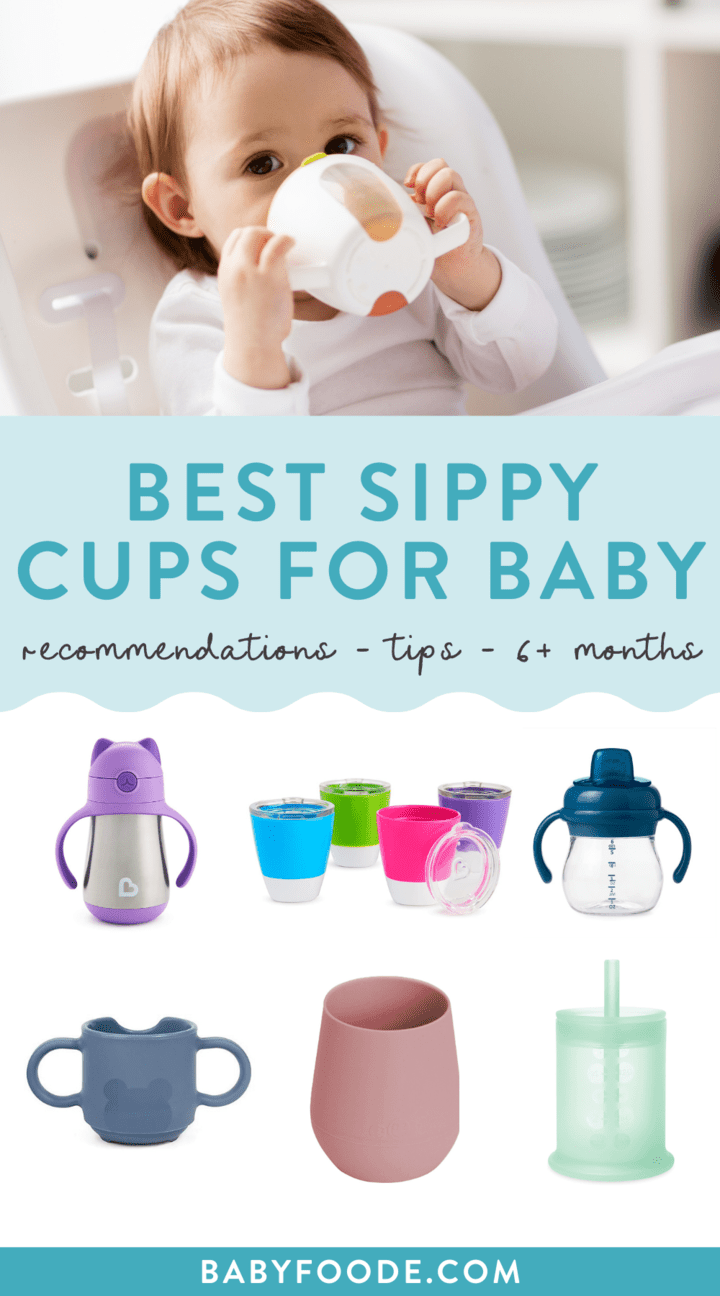
Medically reviewed and co-written by Lauren Braaten, Pediatric Occupational Therapist (OT).
What is a Sippy Cup
The sippy cup (aka, the “Sipster spill-proof sippy cup”) was invented in the 1980s by a mechanical engineer who was tired of cleaning up his toddler’s juice mess. And to be fair, we get it. We’ve all had our fair share of cleaning up messes and spills from our little ones.
Sippy cups have a top to prevent spills, and baby or toddler drinks through either a spout or straw as opposed to an open cup. Some sippy cups have valves that prevent liquid from being spilled even when the cup is tipped upside down. Many parents think of sippy cups as a necessary transition between using a bottle or breastfeeding to an open cup.
Was the original sippy cup made with baby’s oral motor skills and speech development in mind? We’d argue, no. But let’s take a look at what some better options in sippy cups for your baby might be.
Sippy Cups for Baby
For this post, we refer to sippy cups as a small-sized drinking containers with a lid and either a straw or a small hole to drink from. We’ll also briefly discuss open cups. We recommend skipping on what we’ll call “traditional” sippy cups – ones with a hard or soft spout – and going from bottles straight to straw cups, spoutless cups, and open cups.
Why do we recommend skipping traditional sippy cups? Hard or soft spouted sippy cups do not encourage your baby to develop more mature oral motor skills. Baby can usually “get away” with drinking out of one of these cups as if it were a bottle. (If you’ve ever heard another parent mention how easy it was for their baby to transition from the bottle to a traditional sippy cup, it’s because it was easy – too easy.) Traditional sippy cups encourage a more forward tongue position in the mouth, which can affect speech and teeth development.
However, we know that a “one-size-fits-all” approach is rarely the case. If your baby is currently doing well on soft or hard-spouted sippy cups right now, it’s okay! Our goal is simply to give you some info on why it may be helpful to transition off of a traditional sippy sooner (rather than later).
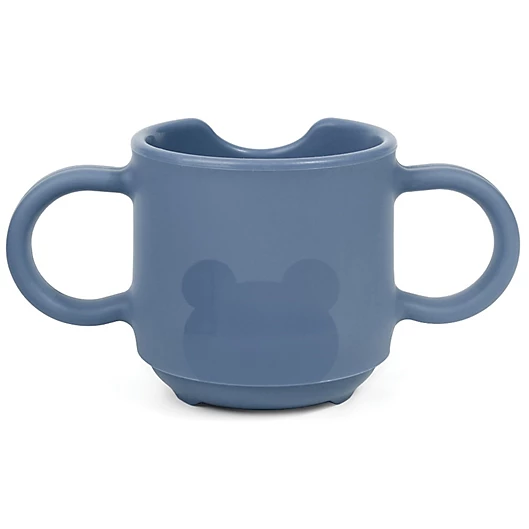
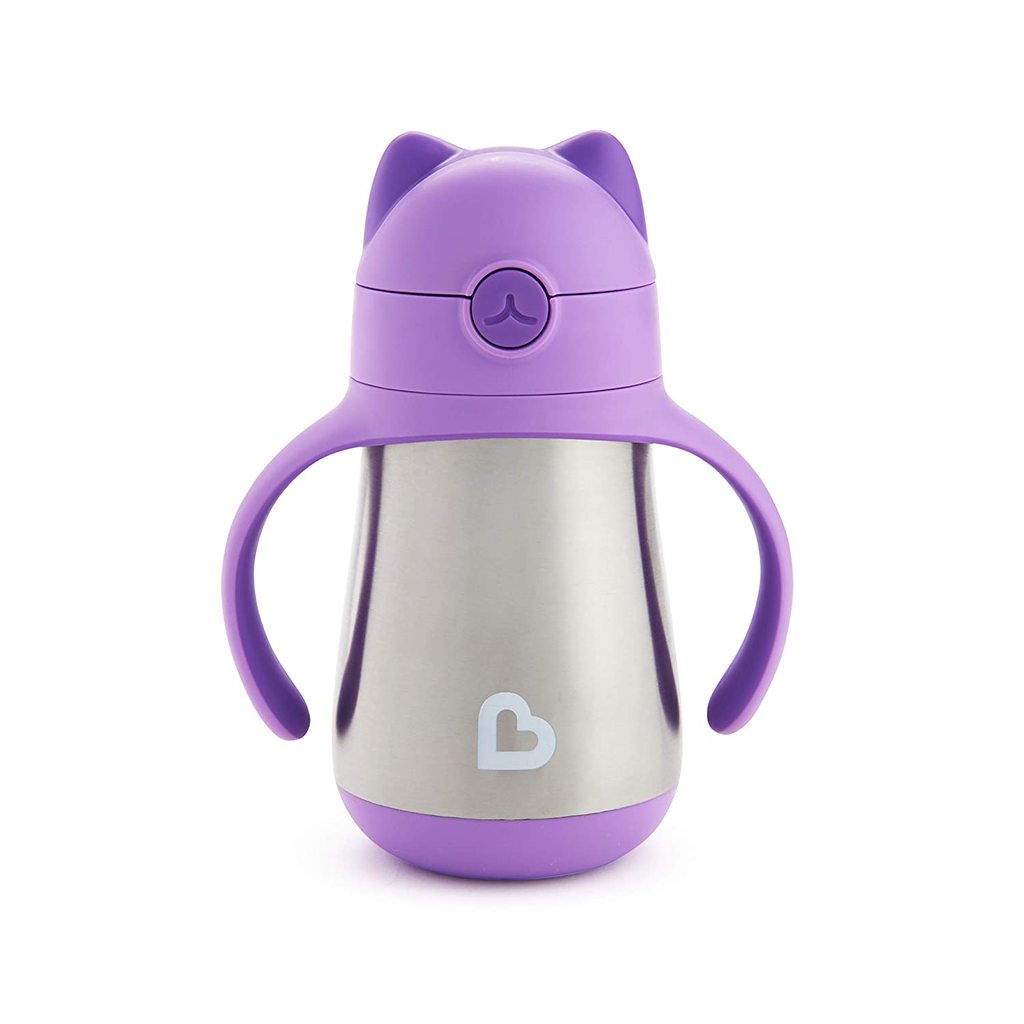
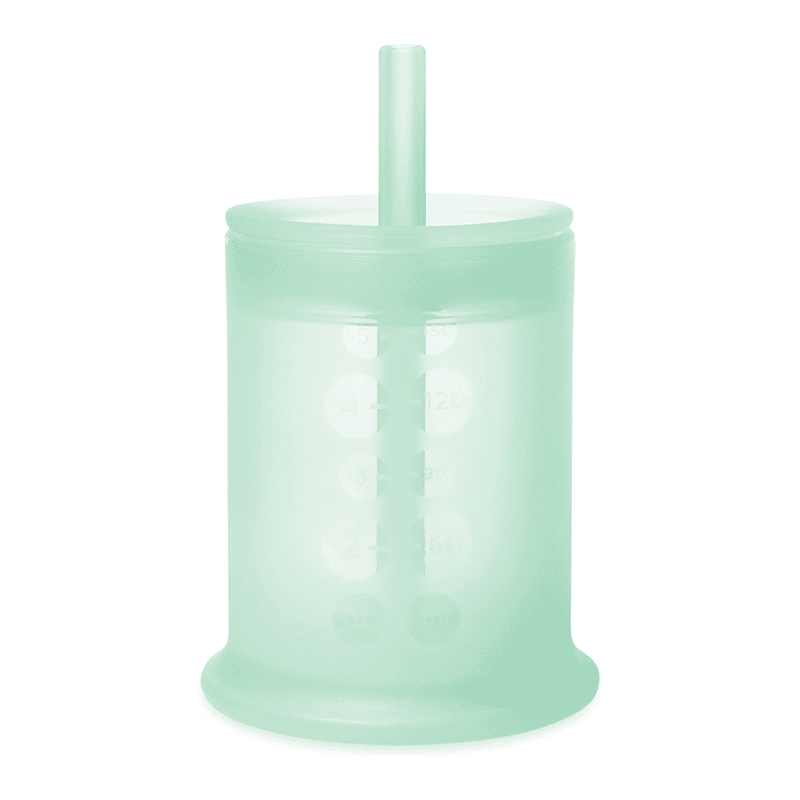
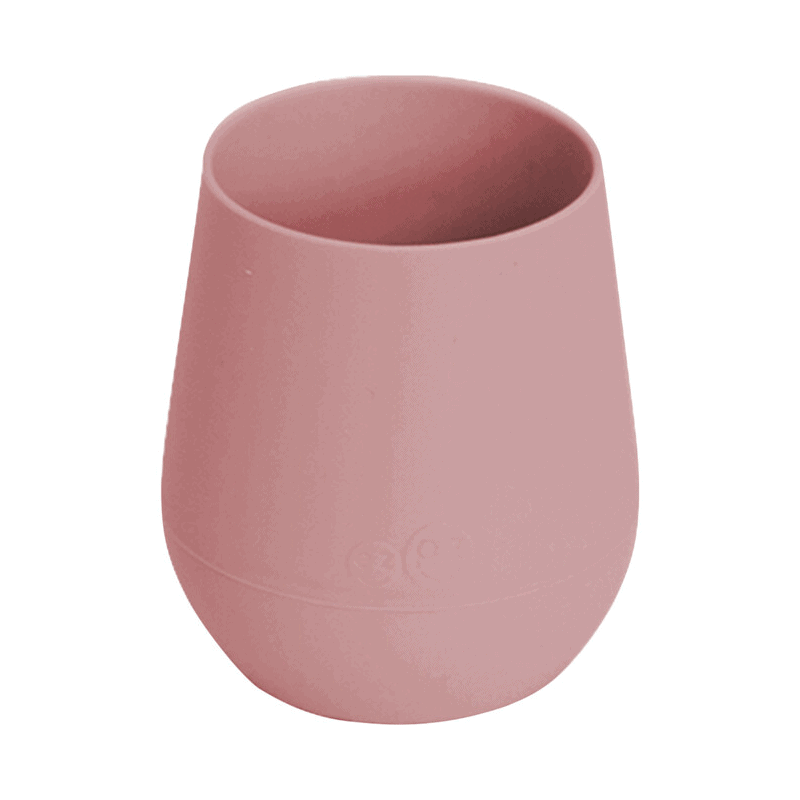
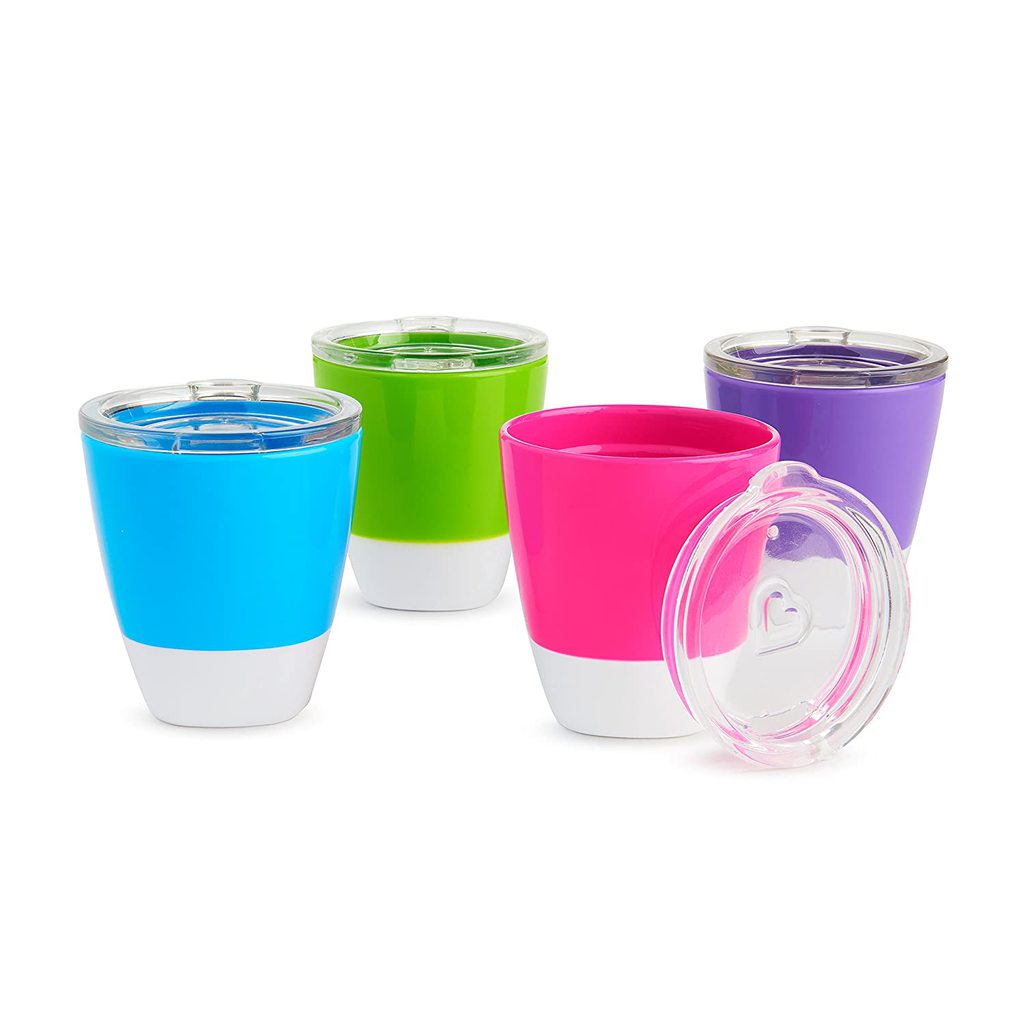
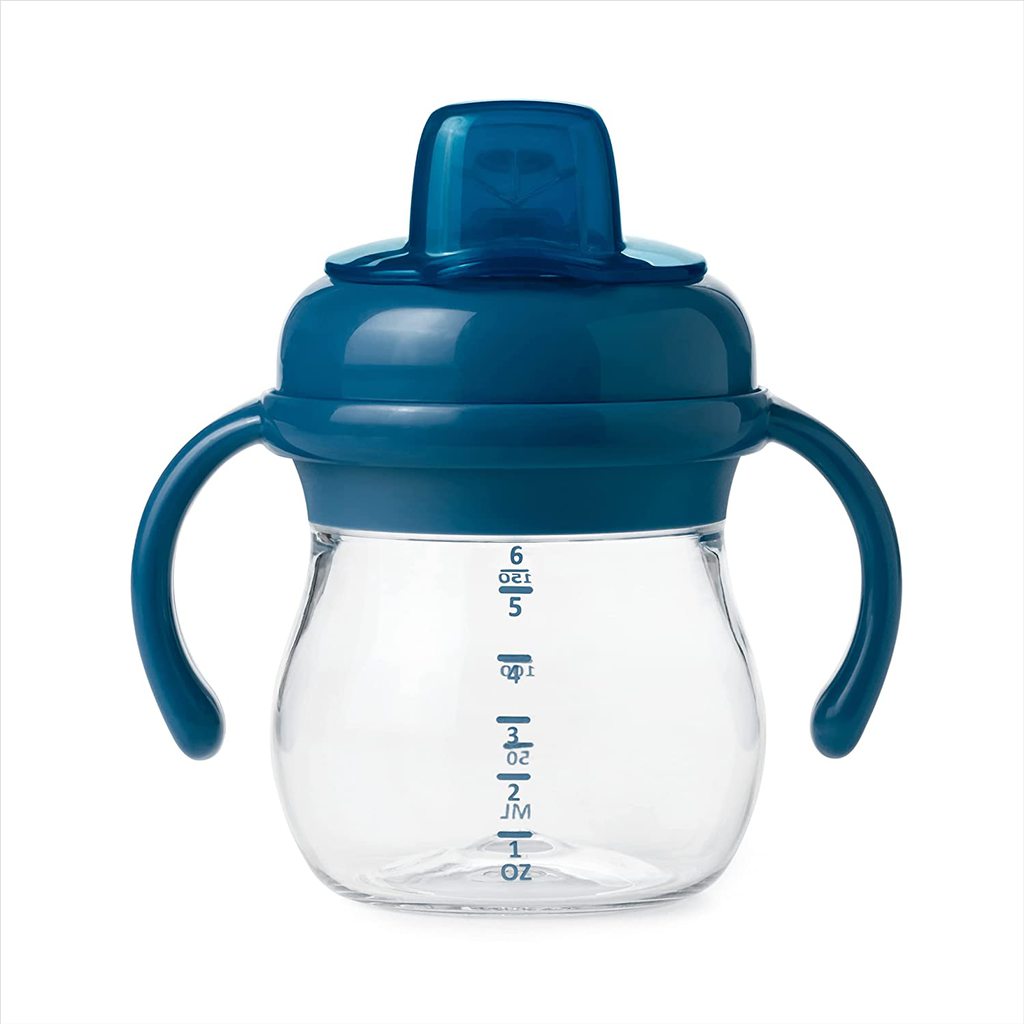
When to Introduce a Sippy Cup
You can introduce a cup around 6 months, usually, around the time that baby also starts solid foods. Whether you introduce an open or straw cup first is your choice, but the end goal is teaching your baby how to eventually drink from both types of cups.
Remember, introducing a cup DOES NOT mean that you need to stop using a bottle or breastfeeding; in the beginning, it’s just to get your little one to start practicing another method to consume liquids. The American Academy of Pediatrics recommends weaning your baby from the bottle completely before they are 18 months of age. Many pediatricians and pediatric dentists often encourage bottle weaning to start closer to 12 months of age. This is because prolonged bottle use may encourage toddlers to fill up on liquids, decreasing their appetite for foods.
During the first several times of introducing a sippy cup, your baby likely won’t end up consuming very much. Until about 1 year of age, drinking from a bottle or breast will still be the primary source of nutrition for your baby. However, practice (and time) makes perfect, which is why we recommend introducing cups at 6 months, instead of waiting until a couple of weeks before your baby’s first birthday.
How to Make the Transition from a Bottle to a Cup
- A planned and gradual transition is best – most little ones DO NOT do well with cutting out all bottles at once. Especially if your baby is not yet consuming a good volume and variety of solid foods, removing a large source of their calories and nutrients in their preferred method of drinking is not recommended. It’s best to start by cutting out one bottle at a time and replacing that bottle with a cup (open cup, straw, or sippy). Most parents find it’s easiest to start by cutting out midday and afternoon bottles and leave morning or nighttime bottles as the last to be eliminated. After you’ve successfully cut out one bottle, wait a few days before you start cutting out the next one.
- Offer a cup at meals and snacks – for instance, if you plan to start by cutting out the bottle closest to lunchtime, you can offer solids foods as you normally would, and then present the cup towards the end of the meal to encourage your little one to eat food first. It may also help to offer the cup towards the end of the meal for the first several trials as the novelty may be somewhat distracting!
- A hands-on approach is key – for the first MANY times you offer a cup, it’s normal for your toddler to turn it over, dump out the liquid, or throw it. Get in the habit of holding onto the cup to help bring it to you little one’s mouth. If needed, take the cup off your toddler’s high chair tray when you are not practicing with it, so there’s less chance for big spills.
Frequently Asked Questions
Let’s face it, there’s a reason why smaller cups made specifically for smaller mouths and hands are helpful. Sippy cups, straw cups, and open cups made just for your baby and toddler are incredibly helpful for practicing and refining the skills they’ll use once they are big kids and beyond. Investing in at least a couple of different cups for your baby will go a long way in developing independence and instilling confidence.
Water or milk/breastmilk are the best liquids to get in the habit of serving in a sippy cup.
The American Academy of Pediatrics recommends children be weaned from the sippy cup by age 2 (keep in mind, this means a traditional sippy cup, with a soft or hard spout, not a straw cup). Prolonged use of traditional sippy cups can contribute to speech delays, changes in facial appearance, increased need for orthodontia, and tooth decay and cavities. Yet another reason why it’s nice to go straight from bottle to a straw or open cup – once less product to transition away from as your toddler gets older (and more opinionated!).
Definitely! Just make sure the open cup is an appropriate size for babies and toddlers. You might decide to use open cups more often at home and use straw cups when visiting family or traveling for limiting spills.
Prolonged use of hard spouted sippy cups may actually cause delays in developing a mature swallowing pattern with the tongue, which may also cause difficulties with dentition, speech, and chewing and swallowing new foods.
Tips for Introducing a Sippy Cup
- Which cup to introduce first – Sometimes, starting with a straw cup may be easier since your little one may have already had practice sucking pureed food off their fingers or eating off of a spoon. However, all babies are different. Just consider sticking to one type of cup at a time (such as an open cup at breakfast and a straw cup for lunch or dinner) to avoid confusion when just starting.
- Start small – both in size of the cup and amount of liquid. The options we’ve recommended below for open and straw cups and are all great sizes for little hands. And although you may do your best to help your toddler bring the cup up to their mouth, some independent learners just want to do it by themselves! Since this can make controlling the flow of liquid more challenging (especially if there’s a lot of it!), make sure to start with a smaller amount of water, especially in an open cup. If your toddler continues to refuse help and still seems overwhelmed by the amount of liquid (frequent coughing may be a sign), you may want to try switching to a straw cup to see if this helps.
- Give simple, consistent cues with each cup practice – such as “pick up, sip, put down.” Have your cup nearby on the table so that you can also model drinking for your little one.
Types of Sippy Cups
Hard Spout
A hard spout sippy cup has a drinking piece made of hard plastic. The cup has to be tipped up in order for the liquid to come out.
Soft Spout
A soft spout sippy cup has a drinking piece made of soft silicone or plastic, similar in texture to a bottle nipple. The cup has to be tipped up in order to make the liquid come out.
Straw Cup
A straw cup has a straw drinking piece just like a regular cup with a straw. The straw often comes apart for easy cleaning. Flip-top lids cover the straw and decrease spills when not in use. Some straw cups have a weighted straw that allows drinking out of the cup from any angle.
Convertible
And lastly, a convertible cup often called training cups, can be used in multiple ways to grow with your baby and toddler. These cups can be used as a straw cup, a spoutless sippy cup, and an open cup.
Best Sippy Cups for Babies
- Munchkin Cool Cat Stainless Steel Straw Cup
- Olababy Silicone Training Cup with Straw Lid
- ezpz Tiny Cup
- Munchkin Splash Toddler Cups with Training Lids
Tips on Using a Sippy Cup
- Note straw length – when using a straw cup, the tip of the straw should just reach the tip of the tongue to encourage a mature swallow pattern to develop. If adding a silicone straw to another cup you already have or if replacing one, you can cut the straw with scissors so that about a half-inch to an inch of the straw sticks out of the cup.
- Test the cup yourself – many parents are often surprised by how difficult some cups can be to extract liquid from, until they give it a try themselves. Removing any valves is actually preferred. Although valves are helpful in limiting spills if the cup is turned upside down, they discourage real drinking and instead encourage ‘sucking’, making it another version of a bottle.
- Give ’em a little extra help to get started – if your little one is still having trouble getting the hang of straw cups, you can try using the Honey Bear Straw Cups or The First Years Take & Toss Straw Cup. These straw cups help move the liquid up the straw when you give the cup a gentle squeeze from the sides.
- Limit milk, juice or smoothies to meal or snack times – this is especially important as your toddler grows older and becomes more mobile. Get in the habit of offering only water in their cup in-between meals or snacks to support appetite for actual foods.
- Try not to stress about spills – there will be lots of them, especially in the beginning. Limiting cup use to the kitchen will help you clean up accidents easily. And you can always practice cup drinking by having a “tea party” in the bathtub after draining out the bath water or take cups outside and have a picnic.
Best Soft Spout Sippy Cups
If you really want to use a traditional a sippy cup, we recommend a soft spout versus a hard spout, as they are somewhat more like a large straw. A soft spout sippy cup might not limit tongue movement as much as a hard spout sippy cup.
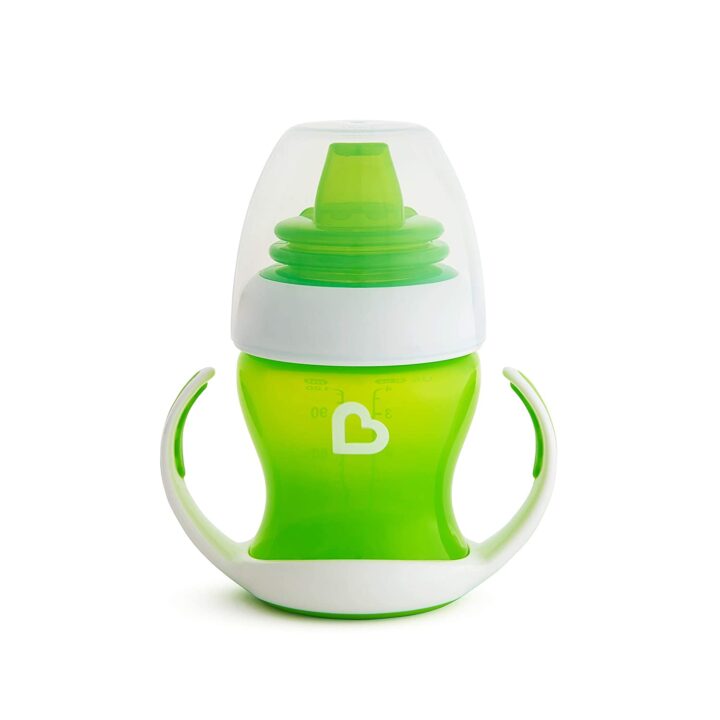
Munchkin Gentle Transition Trainer Cup
The soft, patented spout design is extremely flexible and gentle on babies’ sensitive gums.
- Small size (4 oz) is easy for your baby to manage
- Removable handles for easy cleaning
- BPA-free & top-rack dishwasher safe
- Ounces easily displayed on the side
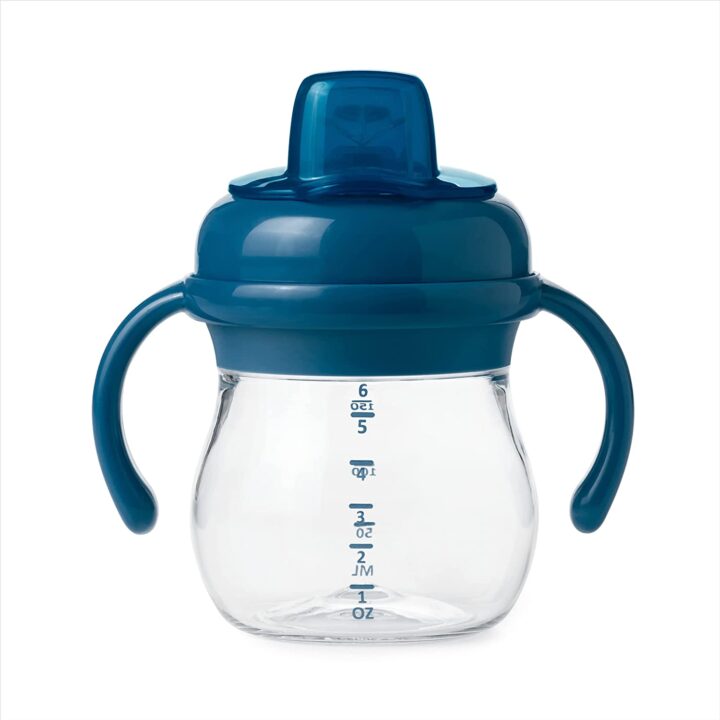
OXO Tot Transitions Soft Spout Sippy Cup with Removable Handles
The OXO Tot Transitions Soft Spout Sippy Cup has a patented, almond-shaped straw that opens with just a light suction and stays closed the rest of the time. That means it won’t leak when dropped or thrown.
- Hinged cap protects the spout, keeping it clean and helping prevent spills in diaper bags
- Spout and cap come apart for thorough cleaning
- Cup features convenient measurement markings
- Dishwasher safe
Best Straw Sippy Cups
We love straw sippy cups for helping develop lip, cheek and tongue strength. They also help your baby learn how to use a straw, which is a skill they can use in toddlerhood and beyond.
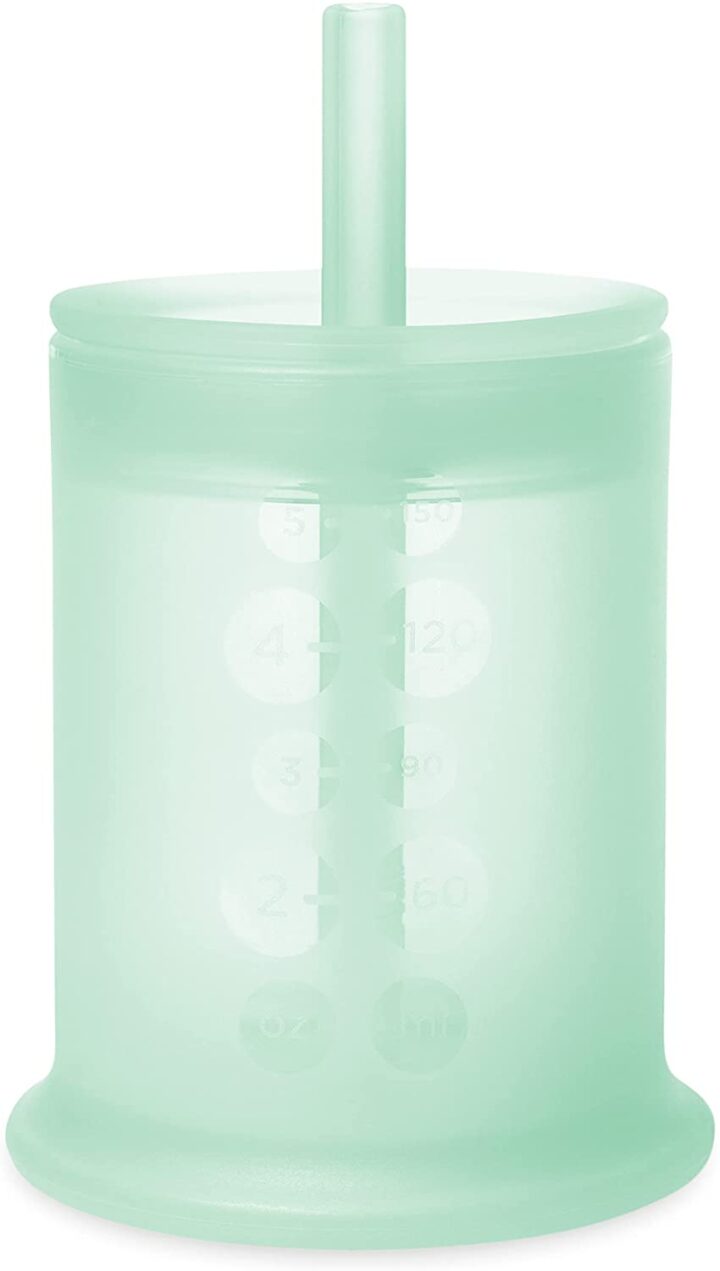
Olababy Silicone Training Cup with Straw Lid
This versatile convertible cup can be used as a mini-open cup, a spoutless sippy cup, or a straw cup. Made of soft silicone for sensitive teeth and easy sipping.
- Wide weighted base provides stability
- A translucent cup helps see how much liquid is left inside
- Easy to read indicators allow measuring for mixing and portioning
- Straw is designed with a small ridge to help prevent it from being pulled out of the cup

Munchkin Cool Cat Stainless Steel Straw Cup
This spill-proof straw cup keeps drinks cool for extended periods of time, making it the perfect companion for home, preschool, and on the go.
- Insulated, double-walled stainless steel straw cup with an 8 oz capacity
- Flip-top lid is easy to open and close
- Spill-proof straw and easy-grip handles
- For 18 months and up, dishwasher safe and BPA-free
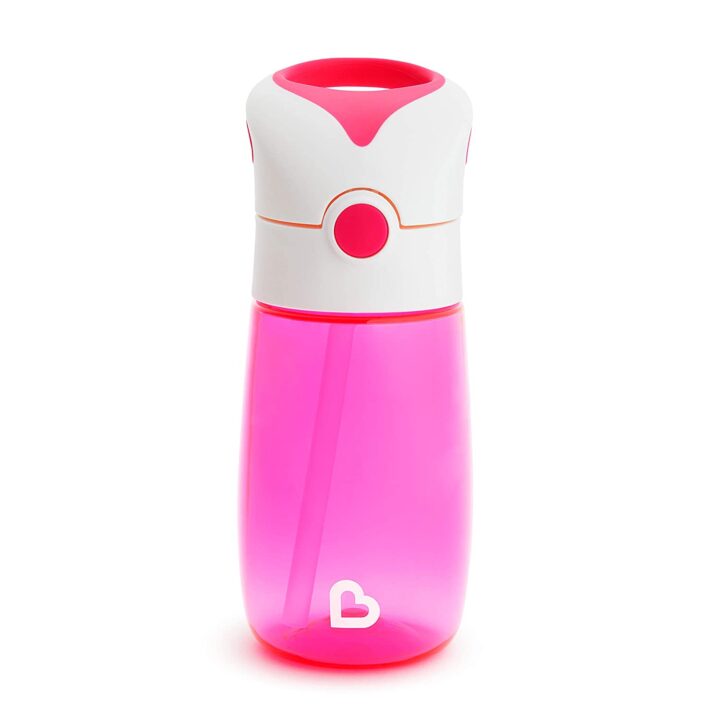
Munchkin Flip and Go Tritan Straw Cup
Valve-free, extra soft silicone straw provides full liquid flow and easy drinking. A spill-proof cap ensures leaks are contained.
- A slightly larger 12 oz capacity may be harder for babies and younger toddlers to manage by themselves, but leaves room to grow into
- Built-in carrying handle in the lid
- Made of ultra-durable Tritan material – safe for drops and throws
- Recommended for 18 months and up, top-rack dishwasher safe, BPA free
Best Open Cup
Open cups that are sized just right for baby provide a realistic experience with drinking out of a cup, yet they’re designed with little hands in mind for fewer splashes and spills.
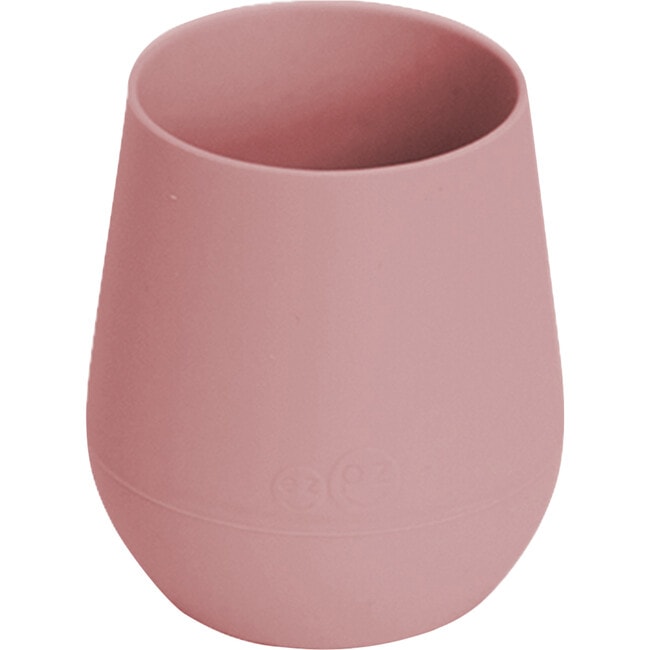
ezpz Tiny Cup
A non-slip grip and angled interior make drinking from an open cup doable for even the youngest babies and toddlers.
- 4 oz size is a great fit for little hands
- Silicone material is gentle on developing teeth and gums
- Slightly weighted bottom provides feedback to limit spill
- Made from high quality silicone that is BPA, BPS, PVC, latex and phthalate free
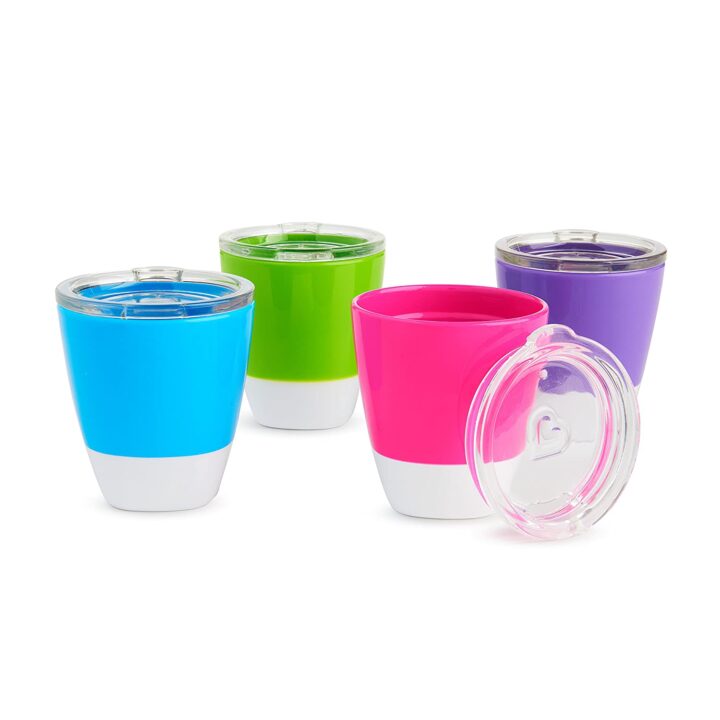
Munchkin Splash Toddler Cups with Training Lids
This colorful batch of sippy cups can be used as an open cup, a spoutless sippy cup and even as a straw cup by adding a straw to the opening in the lid!
- 7 oz capacity works well for smaller hands and mouths
- Sturdy and easy to clean
- Cups nest together for easy storage
- BPA free, top-rack dishwasher safe

Haakaa Silicone Toddler Cups
This training cup is made of soft, flexible silicone to protect developing teeth, yet is still durable and unbreakable.
- Cutout for nose allows baby to drink without having to lift their head, making drinking easier and helping to prevent choking
- Double non-slip handles are easy for little hands to grip
- Made of 100% food-grade silicone, BPA free, and dishwasher safe
- 5 oz liquid capacity, suitable for babies 6 months+

1 Comment on “Buying Guide 2024: Best Sippy Cups for Baby”
Hi there. Great info, thank you. Can you give any info on the Munchkin 360 cups? I read Amazon reviews about most of the cups you listed here, and all the customers compared them to the 360 cup. Seems like a popular item. I’d like to buy a few different cups and wondering if I should skip that one since it’s not on your list here. Thanks!